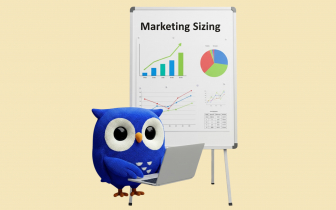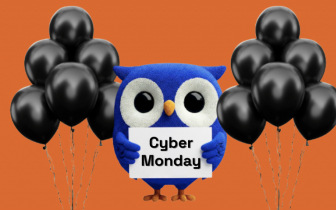How to Build and Run an Effective Customer Advisory Board
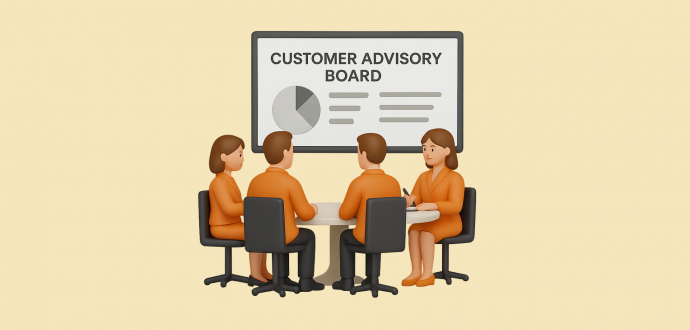
Business books and theories often discuss the importance of listening to customers. They explore different methodologies and tools designed to collect customer feedback and provide guidelines on turning it into actionable insights.
Most of this advice targets a broader customer population and utilizes surveys and focus groups as rather expensive and time-consuming data collection tools.
However, it misses something far more viable — the low-hanging fruit of customer feedback, known as a customer advisory board.
Our mission is to close this knowledge gap. Join us to learn how you can harness and leverage customer board insights with the efficiency and speed of true experts.
What is a customer advisory board, and why do you need one?
People often ask, What does CAB stand for in business? It’s short for “Customer Advisory Board,” a term that may sound formal but simply means a small circle of trusted customers who share honest views on your strategy and products.
The classic customer advisory board definition includes many names, from the basic abbreviation, CAB, to slight variations including client advisory council, customer insights panel, or customer strategy board.
Irrespective of the specific term you’d pick, this board of customer consultants will effectively inform your product and marketing decisions and help avoid expensive mistakes.
Here’s why other leaders rave about CAB benefits:
- 63% of companies report that CAB feedback guides their overall corporate strategy and direction.
- Organizations with robust advisory board initiatives enjoy 24% higher revenues than those without such programs.
- 80% of executives surveyed say they would run their CAB again if given the chance — proof of enduring perceived value.
- Half of CAB hosts (50%) say these boards deliver critical market intelligence that they couldn’t get elsewhere.
- Members of customer strategy boards contribute 57% more in reference programs, testimonials, and thought-leadership efforts than non-members.
A board that feels like a team of your close friends adds a human layer to the data you already collect. Instead of guessing why a new feature flopped, you hear it straight from the people who matter most.
That feedback flows both ways. Customers feel valued, and you gain insights that shape roadmaps, product offerings, messaging, and even culture.
And don’t let all that wisdom stay behind your login portal. Writing expert articles — rooted in your CAB’s real-world examples — can position you as a go-to expert and reinforce the bond with both members and the wider stakeholder audience.
That said, many firms call their CAB the “secret weapon” behind smarter decisions.
How to recruit the right members for your CAB
A customer advisory council doesn’t come knocking at your business office door, nor does it gather and organize sporadically. You must make a discretionary effort to select, recruit, and organize your advisory board members.
Source: Chris Detzel
Ultimately, the more knowledge and care you put into the initial recruitment process, the higher the benefits for you and your business. The whole process resembles that of hiring a skilled employee; however, there are also a few important differences.
Identifying ideal member profiles based on business needs
Picking the right members for your customer strategy board starts with a simple question: What outcomes matter most to the business this year? If the goal is product direction, you need hands-on power users. If market expansion tops the list, look for customers who already sell into that geography.
You should prioritize diversity and think beyond brand names when building out profiles of your potential CAB members. Map each role to a clear business need, then cross-check for overlap.
If your customer insights panel is full of similar buyers, it will echo the same view. Your options? Aim for healthy friction instead. Here is how:
- Mix decision-makers with frontline experts for rounded insight.
- Include fast-growing firms to spot emerging hurdles early.
- Ensure at least one regional outlier for geographic nuance.
- Invite a skeptic to keep the sessions honest and grounded.
- Rotate in a new industry each year for fresh context.
- Track diversity in company size, not just vertical focus.
Most CABs are kept intentionally lean: they typically consist of 10–15 members, ensuring diverse yet manageable perspectives. Within that range, balance seniority and technical depth. You want people able to sign off budgets, yet still close enough to daily pain points.
For that same reason, customer insights panels are more common for B2B, enterprise, and SaaS business models than they are for B2C. Isn’t that natural, as those businesses work with fewer and more senior (prepared and knowledgeable) customers, many of whom are essentially mid and senior business leaders in their organizations?
Close your recruitment process by documenting gaps. If cybersecurity concerns rise and no member owns that area, adjust the invites before the next cycle. In short, design your CAB board like you design a great product: purposeful, user-centric, and tested against real scenarios.
Setting clear goals and expectations for your advisory board
Clear goals turn a friendly chat into a growth engine. Picture yourself clearly what success looks like for the advisory board in one sentence. If you can’t explain it to a colleague in under a minute, sharpen it further.
Be sure to link those goals to real outcomes. Want feature validation? Draft a KPI that shows how often roadmap items shift thanks to member input. Tracking matters because it powers budget requests and future CAB marketing stories.
Use a simple framework to socialize expectations:
- Keep meetings purpose-driven (more about that in the next chapter).
- Share data before sessions, like a digital equivalent of handouts.
- Rotate speaking roles often to keep engagement high.
- Time-box every agenda item (discussions tend to eat up all the time available).
- Close each discussion with clear action owners.
- Recap within 48 hours, e.g., send a short reminder of the key takeaways, action plan, and responsible members (including your corporate team members).
Share the framework with the customer insights panel before the first meeting or call. Knowing the rules frees members to speak plainly without wondering if they’re off-topic.
Fueling engagement and turning insights into action
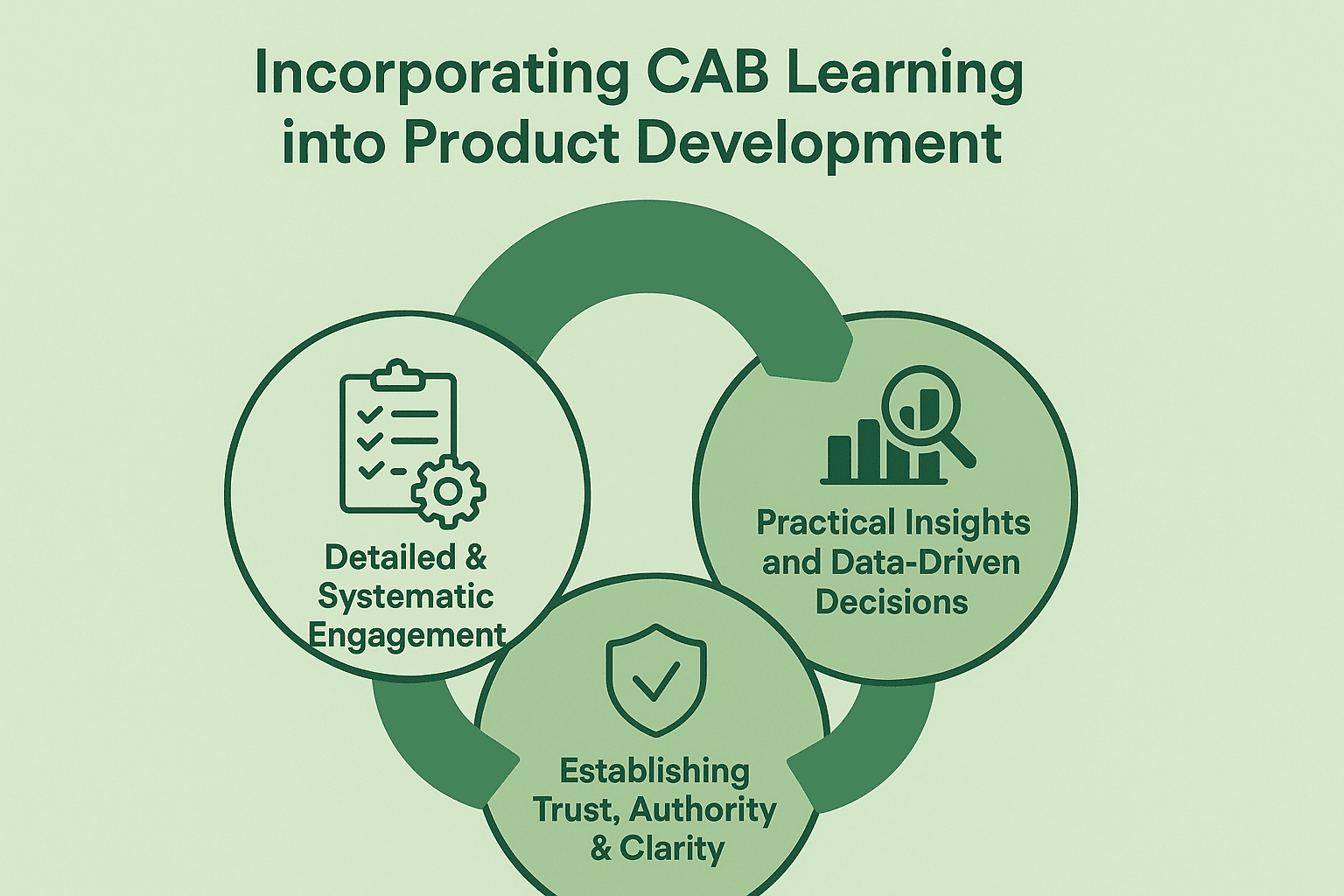
Business priorities change, and so should board goals. Adjust your CAB goals and record updates in a living brief and circulate it, so nobody is guessing.
It’s worth remembering that a customer strategy board works best when members see personal value. So, what can you do about it?
You can share early-access features, invite them to closed betas, and spotlight their wins in public channels. That goodwill keeps discussion lively and feedback blunt, i.e., exactly what you need.
Always aim to feed the customers’ inputs into your business and marketing strategy.
Alternatively, you can immediately turn those fresh insights into credibility by guest posting on industry sites — sharing real CAB stories and lessons learned.
When members see their advice shaping decisions and earning trust, they double down on candor and commitment.
What makes a great client advisory board meeting?
Although we’ve slightly touched upon the CAB meeting efficiency topic in the previous chapter, the importance of this aspect is paramount, and we cannot overemphasize it enough.
Below, we’ll explore some of the most popular customer strategy board meeting formats and explain several customer advisory board best practices, including facilitation techniques and tools.
Choosing the right format: in-person, virtual, or hybrid
With the new technologies at hand, you have a wide choice of formats for your meetings. However, with freedom comes responsibility.
Your chosen advisory council meeting format will drive what you learn and how you act. And keep in mind that when the CAB meets, people need to feel heard without wrestling with logistics.
The golden rule is to align the meeting setting with your goals and the business agenda at hand.
These are your three go-to session formats:
- In-person: Very effective for brainstorming and arriving at a consensus to solve difficult problems. You can effectively visualize and present things while feeling that energy flying around the room. However, its downsides include higher travel and organizational costs, as well as limited availability of CAB members.
- Virtual: Enjoy a fast setup, zero travel expense, easy recording, and quick follow-ups. The downsides are weaker personal bonds, frequent “you’re muted” moments, and the lure of multitasking can drain energy and kill engagement.
- Hybrid: Blends depth and reach by letting local attendees meet in person while remote voices join on camera. On the other hand, expect coordination headaches, tech complexity, and uneven experience without a skilled moderator.
A customer insights panel aiming for roadmap and strategy development often benefits from sticky-note walls and hallway chats, so in-person wins.
If the goal is quick validation of beta features, virtual can do the trick in 90 minutes.
Hybrid tends to work best for global boards when senior members can’t always fly.
Whichever path you choose, stay consistent. Switching formats every quarter confuses members. Pick one primary mode, revisit once a year, and let content — not video-meeting gear and setup — drive value.
Facilitating meaningful conversations

Without a skillful facilitator, even the best CAB meeting in person may not succeed. Where do you find a good facilitator?
You can always hire one, but that’s often expensive and may not be as productive as with an in-house business facilitator.
The other option is to pick and train a facilitator within your team, or to become one yourself. If your company has a developed HR function, it must have people with experience running such meetings.
The ideal meeting facilitator for your CAB will demonstrate most of these capabilities:
- Is exceptional at both listening and talking.
- Succinctly summarizes key thoughts in mind and writing.
- Keeps time gently but firmly, so agendas are always followed.
- Balances vocal members and quieter ones to ensure equal airtime.
- Asks probing questions that surface root issues, not surface complaints.
- Keeps energy high, and knows when to stop to recuperate (coffee breaks)
- Ends each section with clear next steps and owners.
A strong facilitator acts like traffic control — visible enough to guide, invisible enough not to distract.
Their real goal is mutual and corporate benefit, not personal spotlight.
Whether you hire or grow that talent, start small. Practice in internal meetings, gather feedback, and refine. Ideally, try with two or three candidates to diversify your risks and broaden options.
Over time, the facilitator’s skill pays off in sharper insights and quicker decisions.
Tools and platforms to manage meetings

Tech can lift or sink a CAB session. The secret is matching your meeting goals with just enough software. Over-tooling looks impressive, but it drains focus from dialogue.
Allocate enough time to map the session flow. Where do you brainstorm, vote, and record next steps? Each stage deserves the lightest possible platform:
- Google Meet – a popular browser-based video conferencing tool that runs on nearly any device.
- Slack Huddles – good for quick drop-ins for follow-up chats between formal meetings.
- Mural – sticky-note walls for road-map voting and journey maps.
- Coda – live docs that turn bullet lists into trackable tasks.
- Calendly – self-serve scheduling that respects everyone’s calendar.
- Fireflies.ai – AI notetaker capturing action items and speaker sentiment.
Post a one-page “tool cheat sheet” with links and quick tips. Productivity rises when everyone knows where to click next.
Additionally, appoint one person as “platform captain.” Freed from note-taking, they’ll keep the tech invisible and the conversation flowing.
Once your CAB runs like clockwork, package the outcomes into compelling case studies. Pitch those stories to niche publications — not only to showcase your process, but to attract potential customer strategy board members who value your expertise.
How to keep your CAB board engaged year-round
One excellent board session won’t take you anywhere when competitors adopt agile approaches and pursue continuous improvements. For the best and sustainable results, you need consistency supercharged by engagement.
How often should you meet? Finding the right cadence
How many sessions are enough, but not too many? Striking the right cadence keeps your CAB fresh without overwhelming calendars.
Treat frequency like seasoning: just enough pulls out the best flavors of insight.
Research from the Advisory Board Centre shows that advisory boards typically meet four to six times per year — a range many companies call the “sweet spot.”
These quick guidelines will help you find your ideal mix:
- Quarterly meetings are very popular; they foster depth and trust.
- Bi-monthly virtual check-ins maintain momentum going.
- Annual in-person workshops cement long-term strategy shifts.
- Ad-hoc calls are best at tackling urgent product-related issues.
- End-of-year recap (either virtual or in-person) is best for celebrating wins.
Treat those guidelines as a starting point, not a dogma. The idea is to let your board of customer consultants collect rich context in person while preserving agility online.
Make context your guiding star. For example, if your product advisory board oversees fast-moving SaaS releases, monthly virtual pulses may replace an extra in-person trip.
Either way, you should set expectations early and stick to them. Calendar clarity boosts turnout and limits last-minute cancellations.
Finally, measure impact. If decisions still lag, shorten the gap; if discussion feels repetitive, extend it. Cadence isn’t doctrine — it’s a variable your customer strategy board can adjust as business tempo evolves.
Maintaining communication between meetings
Regardless of how good your facilitator is, how often and how well they run your CAB meetings, engagement in such scattered teams tends to fluctuate, and the teams frequently fall apart. If weeks pass in silence, even the most enthusiastic CAB members wonder whether their input mattered.
Unless you keep the communication going.
A steady heartbeat of interactive communications shows you’re listening and acting. While pursuing this strategy, mix quick wins with deeper dives.
For instance, using surveys and pulse checks gives you instant temperature reads while respecting busy calendars. Anchor communication around three pillars: recap, progress, and preview.
Source: PeopleInsight
Here are a few ideas on what you can do:
- Send video recaps within forty-eight hours of meetings.
- Launch fortnightly micro-surveys gauging mood and priorities.
- Offer early-access links inside a private Notion page.
- Schedule ten-minute coffee chats for rapid clarifications.
- Post quarterly dashboards mapping feedback to shipped features.
Rotate formats, so no single content or channel becomes noise. A customer insights panel is more likely to reply when content feels personal instead of automated.
Remember that creative visuals often work faster and reignite engagement better than text — even a quick GIF of a new UI can spark commentary more than paragraphs.
Recognizing and rewarding ongoing participation and input
People stay where they feel valued. Your customer insights panel may meet only a few times a year, but appreciation must flow all year long.
In a survey of CAB practitioners, 77% cited “product and solution direction” as the top benefit they derive from their advisory boards. Collecting and highlighting similar statistics in every recap of your CAB collaboration sets the stage for meaningful thanks.
Recognition starts with visibility. Quote members by name in release notes, social posts, or a leadership newsletter. When their peers see them shaping big moves, pride skyrockets, and so does loyalty.
Rewards don’t have to blow budgets. Early feature access, an informal Q&A session with your CEO, or a behind-the-scenes roadmap tour feels exclusive and costs little. These gestures remind contributors why the customer strategy board matters.
Think in terms of career wins, too. Offer conference speaking slots or co-authored blog posts for standout insights. Publishing under the “product advisory council” banner transforms quiet advisors into recognized thought leaders. Watch them grow and mature, as many of them can become your brand ambassadors or influencers who promote and vouch for your products at no additional cost.
Bonus tip: always ask what kind of acknowledgement resonates best. Some members want public shout-outs; others prefer a handwritten note. Matching style to person shows genuine care and keeps your panel engaged long after the meeting ends.
10 common mistakes to avoid when running CAB
Many things can go wrong with an advisory group, but while some of them may not depend on your wrongdoing, others can be classified as a direct result of your actions. Essentially, the latter are your mistakes, and yours only.
For practical reasons, let’s focus on the second category, as these are mistakes that you can control and effectively avoid. Each mistake description will come with a brief roadmap of how to prevent such a mistake from occurring in the first place.
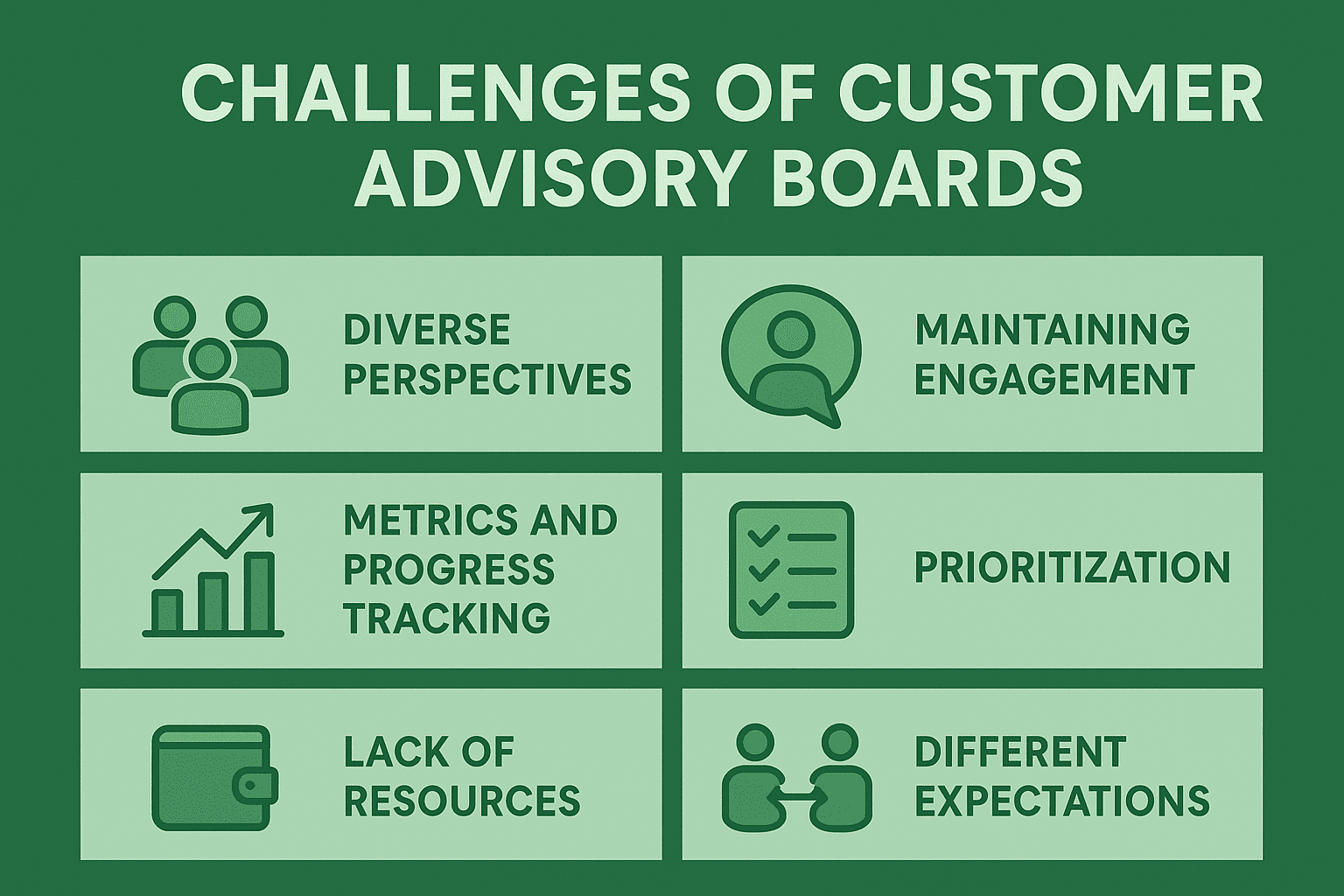
1. Stuffing five topics into a single agenda
Less is more, they say. For running CABs, this applies directly. Squeezing pricing, roadmap, support, and marketing updates into one hour guarantees superficial input and zero ownership.
Limit each meeting to two heavyweight items and schedule follow-up calls for overflow. You see, when attendees arrive aligned, discussions turn out to be more fruitful, because everyone actually has room to think.
2. Sending a 25-page pre-read
Monster PDFs trigger skim mode, not preparation. Replace that novella with a two-page brief and a six-slide deck. Highlight exactly what feedback you need and why.
A lighter lift beforehand sets the stage for heavier thinking on the day, which is the only thing that counts.
3. Picking advisors solely for brand prestige
Prestige logos look stunning in internal documents, yet those executives may never join calls or log into the product.
Prioritize passion, usage depth, and willingness to disagree instead. Interview candidates briefly, probing for curiosity fit. A vocal mid-market champion who lives in your tool daily can surface more actionable details than a silent Fortune 500 VP.
4. Treating silence as consent
The absence of questions or comments does not equal agreement. Introverted or junior members may hesitate to challenge the group.
After presenting an idea, pause for eight seconds — long enough to feel awkward — and invite verbal (periodically written in chat) comments or questions. That extra breathing room often yields surprising ideas and suggestions that would have stayed hidden.
5. Underutilizing CAB feedback
Feedback is the breakfast of champions — a buzzphrase, indeed, but worth reiterating here. Unfortunately, many tend to forget that and waste the feedback they collect during meetings.
Assign each recommendation an owner, due date, and public status column. Update progress monthly—even “delayed due to budget” is better than silence. This transparency will help you convert skepticism into continued engagement.
6. Over-promising delivery dates
“Next quarter” sounds exciting until procurement or compliance derails the plan. Share realistic timelines with clear caveats and checkpoint dates. When delays happen (and they will), communicate early. Trust grows faster with honesty than with ungrounded optimism.
7. Running a homogeneous room
If every attendee shares the same title and region, expect identical opinions. Blend executives with frontline users, long-time customers with recent converts, and at least one geographic outlier. Friction born of diversity surfaces blind spots before they morph into costly surprises.
8. Clinging to outdated agendas
Business priorities shift; your board of customer consultants' agenda must, too. It doesn’t make much sense to discuss machine learning when modern AI is mostly grounded in advanced neural networks, reinforcement learning, and real-world modeling.
Review objectives annually with the customer strategy board, pruning obsolete goals and adding new ones. A living agenda keeps efforts aligned with evolving strategy and prevents meetings from reciting last year’s news.
9. Neglecting cultural nuances
Not every idiom or joke will be perceived equally by all participants. And not because they are all different, but because they come from different cultures.
Respect those cultural differences. Use plain language, clarify acronyms, and schedule around major regional events.
In the end of the day, cultural empathy may sound like a trifle, but it holds the power to invite richer candor and prevent unintentional disrespect.
10. Hoarding insights inside the product team
Marketing, success, and operations all benefit from board wisdom. Share monthly digests across departments. Cross-pollination turns localized ideas into company-wide improvements and elevates the perceived importance of the customer insights panel.
Customer advisory board examples worth following
Nothing proves a point better than a good example. In this chapter, we’ll showcase three business success stories, each from a different industry. What unites these stories is the pivotal role of customer advisory bodies and their ability to achieve tangible business results.
1. UPS Capital — sharpening e-commerce positioning
UPS Capital, the financial services arm of UPS, offers cargo insurance and payment solutions. As online merchants mushroomed, product-market fit grew fuzzy and Net Promoter Scores slipped.
A lean, 12-member customer insights panel of high-volume merchants and platform integrators was set up. Over successive quarterly sprints, the panel critiqued messaging, demo flows, and UI mock-ups.
Within six months, UPS Capital relaunched its website and onboarding flow. Post-launch surveys showed double-digit NPS gains among test merchants, and funnel analysis revealed a faster “time-to-first-transaction.”
Leadership has since expanded the board’s remit to inform risk-model tweaks for buy-now-pay-later offerings, citing the initial wins as proof of value.
Source: Ignateag
2. Workday — proving ROI to the C-suite
Workday sells enterprise HR and finance clouds to some of the world’s largest employers. Because every release affects payroll and compliance, its product missteps can be costly.
By 2021, executives feared that “inside-out” roadmap planning was slowing deals. They expanded an existing executive CAB into multiple regional boards, each packed with CHROs and CFOs from Fortune 500 accounts.
Forrester’s Total Economic Impact™ study of the program found “an astounding 431% return on investment over three years,” driven by faster sales cycles, larger deal sizes, and reduced re-work on unwanted features.
One Workday VP summed it up: “Every dollar we spend on the customer insights panel comes back fourfold in product savings and pipeline.”
Source: Chrisdetzel
3. Iron Mountain — converting insight into net-new revenue
Iron Mountain manages information assets for 95 percent of the Fortune 1000. In 2014, its growth had plateaued as legacy paper-storage demand fell.
The firm launched a focused customer strategy board composed of senior information-management leaders from top financial-services clients. Meetings alternated between deep-dive round tables and virtual check-ins, all facilitated by the customer marketing team.
Board members co-created new digital-vault and compliance-analytics offers, then acted as design partners and on-stage references. In the first 18 months, the program achieved:
- Engaged 400 new customer advocates.
- Influenced $335k in active pipeline.
- Booked $108k in closed business tied directly to board-generated leads.
Iron Mountain’s CMO later called the board “a six-figure engine we built for mid-five-figure cost.”
Source: Customerthink
The bottom line
These three cases — spanning fintech, SaaS, and information management — demonstrate how a well-designed CAB or customer insights panel can identify gaps and strategic opportunities and boost hard business metrics, not just engagement.
Customer board trends in 2025: what’s changing and why it matters
It’s a technological and informational tsunami we live in — no business area is immune to changes, the customer advisory council being no exception. This technological tsunami is standing behind most trends and transformations happening as we speak, with CABs all around the world.
The question is, how can you leverage these trends for the benefit of your business? Let’s explore some of the most profound trends to help you find the answers.
AI-driven insights: How machine learning is shaping board feedback
AI in a CAB meeting sounds like an alien technology, yet it solves a dull problem: information overload. A one-hour session can spawn 10,000 words of audio. Natural-language models now compress that “big data” into bullet points before the recap email goes out.
Sentiment scoring spots emotional spikes — say, frustration around onboarding length — so product teams can queue quick wins without guessing. Predictive tagging then links that frustration to product data, sizing the problem quantitatively.
Need more evidence? Here is what AI can do for your advisory board:
- Spot rising problems before they trend (and leak!) externally.
- Map sentiment changes between quarterly sessions (the dream of every seasoned survey manager).
- Flag outliers in data, demanding deeper one-on-one follow-up meetings.
- Tie voiced pains to exact revenue segments.
- Produce bite-size dashboards for the top management quick reads.
However, don’t over-rely on AI. Always review AI suggestions through a human lens, especially when sentiment analysis risks reading sarcasm as praise. The tech should amplify, not override, the collective wisdom of your customer strategy board.
Measuring ROI: new KPIs for business-driven board success
Source: ROI Institute
Measuring the return on a CAB used to feel like a mission impossible. Teams tracked vague “engagement” and called it a day. Today, finance wants harder proof: How many dollars did those Zoom squares actually create or save?
Link each board idea to a mini business case. Was it a new upsell path, a support shortcut, or a marketing angle? When revenue lands, the link is clear, and nobody argues value.
Your starter KPI toolkit:
- Upsell uplift: added revenue from board-suggested bundles.
- Feature adoption rate: percent of users switching to board-born releases.
- Churn reduction: departures versus last year in board member segments.
- Time-to-decision: days from idea raise to green-light vote.
- Marketing reach: press or social hits tied to board quotes.
- Cost-to-insight: dollars spent per validated recommendation.
If you cannot find your ideal metrics in this list, check out this broader marketing KPIs guide specifically designed for the B2B sector.
It’s important to update the numbers quarterly and roll them into a one-page dashboard. Share the sheet with the customer advisory board — it shows that their time matters.
Remember, perfect accuracy is nice, but trend lines matter more. If churn falls each quarter, the program is paying off even without PhD-level stats.
Data democratization: empowering advisory board members with real-time dashboards
Before we finish, remember that data democratization is more than rolling out BI tools. It’s about equipping your CAB with the precise controls to chart their own course.
Hand your CAB members a user-friendly data portal instead of weighty manuals — democratizing data is about tool clarity, not never-ending documentation.
Set up a lightweight dashboard (e.g., Looker, Power BI, even Google Data Studio) focused on KPIs the board actually influences. Forget vanity stats like engagement or social followers.
Grant view access with edit rights on filters. When a member spots a spike in ticket volume after a release, they can highlight it live, saving weeks of email ping-pong.
Schedule quarterly “data clinics” where your analyst walks through new charts and field suggestions. Those who are curious and active will attend all of them. Their habit will turn numbers into a shared language instead of an internal secret.
Conclusion
Building and running a customer advisory board may seem like a fancy corporate toy and an additional expense for many. However, our arguments and case studies surfaced in this article prove otherwise.
All in all, we’ve covered a lot of ground by now — from recruiting a balanced customer insights panel to using AI for instant takeaways, so let’s boil it down. For your convenience and if you feel a little bit overwhelmed, tuck away just these five lessons:
- Create a diverse roster of CAB members. Mix decision-makers, power users, and skeptics for richer debate.
- Lock clear goals and KPIs. A one-sentence mission for the board's work, plus a living dashboard with key KPIs, will keep everyone honest and engaged.
- Blend meeting formats wisely. For example, in-person for deep dives, virtual for quick validation, and hybrid when geography demands.
- Keep the heartbeat alive. Short pulse surveys and Slack recaps maintain momentum between meetings.
- Share the wins. Public recognition and real numbers turn advisors into lifelong advocates and, potentially, influencers as well.
Just as important as following the key best practices is steering clear of these five most costly classic traps:
- Stuffing several topics into one agenda. Depth is more important than scope. Besides, you cannot physically cover all issues in a single meeting.
- Sending 25-page pre-reads. Respect reading bandwidth or expect skimming.
- Inviting prestigious logos that never show up. Genuine passion and hands-on experience drive better feedback and stronger participation than simply recruiting an advisor because their brand looks impressive.
- Assuming silence equals agreement. Give your members space, encourage them to share more, and make it safe for them to speak up if they don’t agree.
- Letting feedback die in the backlog. Instead, turn feedback into clear action points, assign owners, and broadcast progress at least monthly.
Get these foundations right, and your customer strategy board shifts from “nice-to-have” to revenue engine. Ignore them, and you’ll end up with an expensive coffee club.
The choice is in your hands, but don’t waste much time contemplating, as many market players have long been pushing their corporate pedal to the metal using CABs to their advantage.





